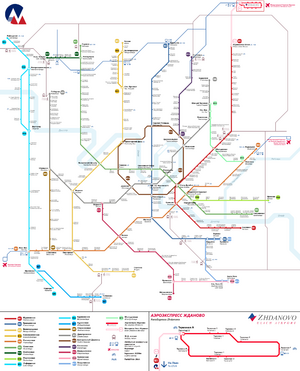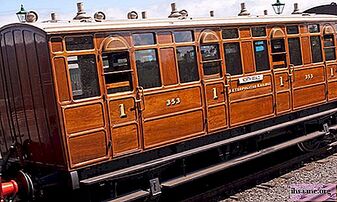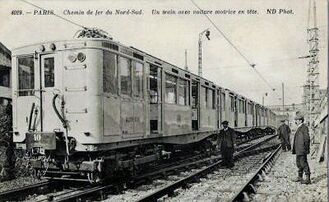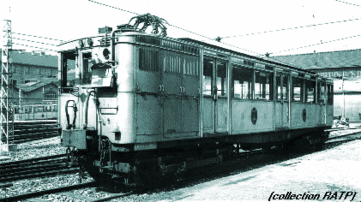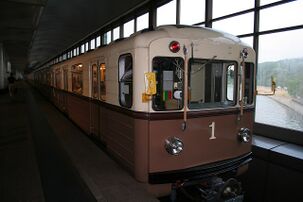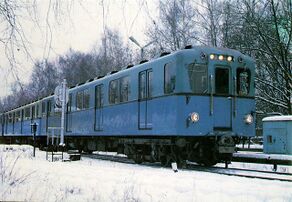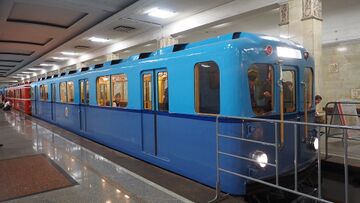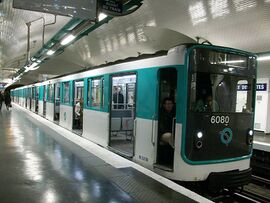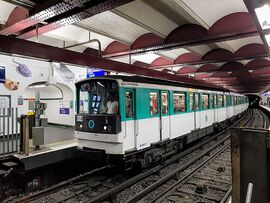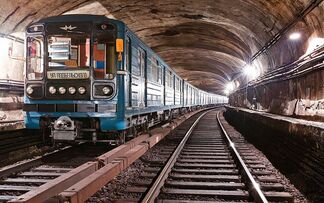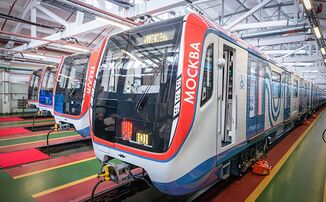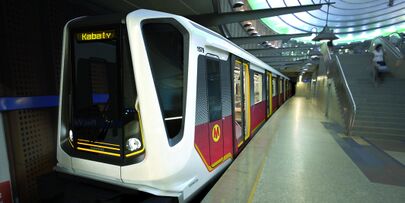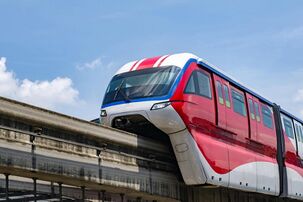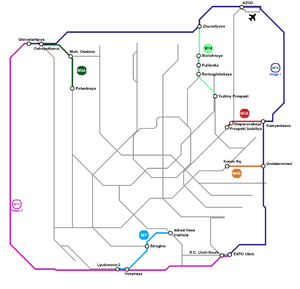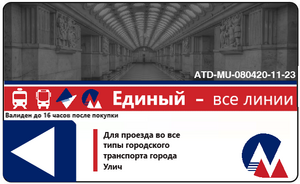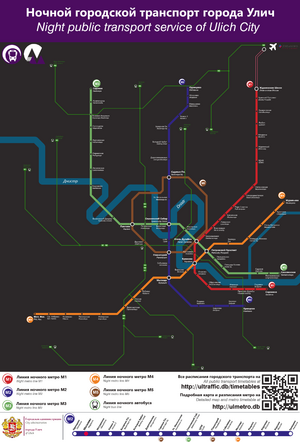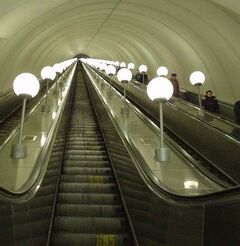Ulich metro: Difference between revisions
The ©rusader (talk | contribs) m (→External links) |
The ©rusader (talk | contribs) mNo edit summary |
||
| Line 495: | Line 495: | ||
* [https://drive.google.com/file/d/1iRM35QfxituCDgrxTJLLi6f1JYH_FUUr/view?usp=sharing High-resolution map] | * [https://drive.google.com/file/d/1iRM35QfxituCDgrxTJLLi6f1JYH_FUUr/view?usp=sharing High-resolution map] | ||
[[Category:Economy of Dulebia]] | [[Category:Economy of Dulebia]][[Category:Metro systems of Aurorum]] | ||
{{Template:Rapid transit in Dulebia}} | {{Template:Rapid transit in Dulebia}} | ||
Revision as of 08:22, 21 September 2021
This article is incomplete because it is pending further input from participants, or it is a work-in-progress by one author. Please comment on this article's talk page to share your input, comments and questions. Note: To contribute to this article, you may need to seek help from the author(s) of this page. |
 | |||
 | |||
| Overview | |||
|---|---|---|---|
| Native name | Улический метрополитен | ||
| Owner | Government of Ulich | ||
| Locale | Ulich cities of Efimovo, Lyubimovo, Muravyovo, Lefordovo - within Ulich-city | ||
| Transit type | Rapid transit | ||
| Number of lines | 21 (including Zhdanovo AeroExpress and the Ulich-Zhdanovo monorail, excluding Ulich Outer Diameter) | ||
| Number of stations | 319 329 (including 10 stations of the Zhdanovo AeroExpress) | ||
| Daily ridership | (average) 3.117 million | ||
| Annual ridership | 2.7 billion (2018) | ||
| Chief executive | Stepan Radonetsky | ||
| Website | http://ulmetro.db/ | ||
| Operation | |||
| Began operation | 31 January 1909 | ||
| Operator(s) | Rapido DB | ||
| Headway | Peak hours: 3-4 minutes Off-peak: 6-12 minutes | ||
| Technical | |||
| System length | 417.9 km (259.7 mi) 445.7 km (276.9 mi) including Zhdanovo AeroExpress and Ulich-Zhdanovo monorail | ||
| Track gauge | 1,520 mm (4 ft 11 27⁄32 in) | ||
| Electrification | 825 V DC third rail, 3 kV DC overhead line | ||
| Average speed | 36.25 km/h (22.52 mph) | ||
| |||
The Ulich Metro (Dulebian: Улический Метрополитен, Ulichesky Metropoliten) is a rapid transit system serving the capital of Dulebia, the city of Ulich, as well as the neighbouring cities of Efimovo, Lyubimovo, Muravyovo and Lefordovo within the Ulich-City District, and the cities of Bogdanovo, Sovetsk and Zhdanovo, located in the Ulich Oblast. The system was opened in 1909, with one line running along the river Dnistr (currently part of Zhdanovskaya Line), connecting then eastern Ulich with the suburban town of Sorokino, with 9 stations in total. The system is thus the oldest underground urban railway system created in Dulebia, and one of the oldest in Erdara. As of 2020, the Ulich metro system has a total length of 445.7 km (276.9 mi) including Zhdanovo AeroExpress and Ulich-Zhdanovo monorail, and 329 stations in total. The system has the most number of stations in the world, and is the longest underground railway system currently operational. The system has underground, overground, ground-level and semi-underground stations, as well as multi-level stations at line intersections. The deepest section is located at the Hotel Dulebia transfer hub, where 3 stations are located beneath the ground, with the deepest (Hotel Dulebia station on Sovetskaya Line) being 89 metres below ground-level. The Ulich metro is the second-busiest metro system in the world by annual ridership. Due to its rich history, the metro has examples from numerous architectural styles popular in Dulebia throughout the 20th century, with its oldest stations being build in revivalist style, with examples of Art Deco, Avant-Garde, Brutalist, Constructivist, Socialist Classicism and Neomodern and Neofuturist architecture along different lines and stations. This makes the Ulich metro a popular tourist attraction, and many name it as the trademark of the city itself.
History
During the Dulebian Empire
Socialist era
Modern history
Operations
Infrastructure
The Ulich metro operates as a fully state-owned enterprise. The system has a total length of 445.7 km (276.9 mi). It consists of 329 stations, and is organized in a spoke-hub distribution paradigm, which means that most lines spreading radially from the city centre to the outskirts of the city, with several lines serving as short connections between bigger lines. Line M10 forms a 21 km long circle in the center of the city which gave it the name Ulich Central Diameter line, connecting with the majority of the lines in the system and having some of the most overloaded stations in the whole metro. The majority of the stations are underground, however, there also ground level and elevated stations in various parts of the system. The Ulich-Zhdanovo is the only completely-elevated line, and the one with the smallest number of stations (two).
Railways
The Ulich metro uses the standard Dulebian gauge of 1,520 millimetres (60 in), similar to other Dulebian railway systems. Electricity is supplied by an underrunning third rail with a supply of 825 V DC, with the exception of the Ulich-Zhdanovo monorail. The average distance between stations is 1.5-kilometre (0.93 mi); while the shortest section is 673 metres (1,647 ft) long and the longest is 20.7-kilometre (12.9 mi), the Ulich-Zhdanovo monorail. The average speed of the trains in the system is 36.25 km/h (22.52 mph), with the highest speeds being achieved on the Ulich-Zhdanovo monorail - 105-kilometre-per-hour (65 mph).
Depots
Almost every line of the system is equipped with at least one depot, with some of the longest lines having as many as three depots. The depots are located in the following locations, and serve the following lines:
 Hadarkovskaya street, Lyubech
Hadarkovskaya street, Lyubech

 Gurkovskaya street, Children's Palace of Arts, Kombinat
Gurkovskaya street, Children's Palace of Arts, Kombinat Milyukovskaya street, Sorokino
Milyukovskaya street, Sorokino Sovetskaya street, Odintsovo
Sovetskaya street, Odintsovo

 Marshalova street, Birulyovo
Marshalova street, Birulyovo

 Kashtanovskaya street, Lipovo
Kashtanovskaya street, Lipovo
 Belomorsky park, Savyelevka
Belomorsky park, Savyelevka
 Ramensky railway station, Kommunarka
Ramensky railway station, Kommunarka

 Severopolskoye depot
Severopolskoye depot

 Magistrsky railway station, Leonovskoe boulevard, Pobeda
Magistrsky railway station, Leonovskoe boulevard, Pobeda Malyshevskoye depot
Malyshevskoye depot
 Efimovo depot
Efimovo depot Putilovsky railway station, Kupechesky
Putilovsky railway station, Kupechesky Mirny monorail depot, Zhdanovo, Ulich City
Mirny monorail depot, Zhdanovo, Ulich City Ulich Zhdanovo airport train depot
Ulich Zhdanovo airport train depot
Rolling stock
Imperial period
Early post-civil war period
1940-1960
Late socialist period
Modern era
Wi-Fi and network coverage
Lines
As of 2020, the Ulich metro consists of 21 operational lines, including the Zhdanovo AeroExpress and Ulich-Zhdanovo monorail. Each of the lines is assigned its own colour and number, as well as a name. The lines are usually named after the districts their construction started at (e.g. Zhdanovskaya Line is named after the district of Zhdanovo (not to be confused with the city of Zhdanovo in Ulich Oblast) in northeastern Ulich, with its historical name, Sorokinskaya, being dropped in 1992), however, there are several exceptions: some lines are either named after their function (Ulich-Zhdanovo monorail), location and shape (Ulich central diameter), or have historical names (Sovetskaya Line). One line in the system did not receive its unique colour (Buryanovskaya Line), and one did not receive its own bullet (Zhdanovo AeroExpress).
The upcoming station is announced on the train by a female voice before departure, and the last station of the line is announced before arrival of the train by male voice on the station. The metro system offers direct connection to several bus lines to the three passenger airports of Ulich, transfers to some of the commuter rail, and a direct connection to Ulich Zhdanovo International Airport and its inter-terminal railway.
| Color | Line Bullet | Name | Original name | Connections | First opened | Stations | Length km |
|---|---|---|---|---|---|---|---|
| Red | 
|
Zhdanovskaya Line | Ждановская Линия | Zhdanovskoe Shosse to Molodyozhnaya to Hotel Dulebia to Kryukovo to |
31 January, 1909 | 38 | TBA |
| Blue | 
|
Kravtsovskaya Line | Кравцовская Линия | Sadovaya Square to Spassovsky Sobor to Kerchevsky Library to Planetary to Mytishchi to Birulyovo to Beryozki to Kravtsovo to |
11 March, 1926 | 26 | TBA |
| Yellow | 
|
Belogorodskaya Line | Белогородская Линия | Belogorodskaya to Severny Prospekt to Proletarsky Dvor to Vasilevsky Dvorets to Vnukovo to Pionerskaya to |
22 May, 1934 | 28 | TBA |
| Gold | 
|
Sokolnicheskaya Line | Сокольническая Линия | Belogorodskaya to Severny Prospekt to |
1 April, 1986 | 9 | TBA |
| Orange | 
|
Pionerskaya Line | Пионерская Линия | Faculty of Philosophy to Stahanovka to Pionerskaya to Lesnaya to Mytishchi to Kryukovo to Pionerskaya to Petrovsky Prospekt to Bolotnaya to |
25 December, 1942 | 28 | TBA |
| Green | 
|
Sovetskaya Line | Советская Линия | Kommunarka to Vasilevsky Dvorets to Pavlovo to Lesnaya to Mytishchi to Kryukovo to Pionerskaya to Spassovsky Sobor to Ivolzhskaya to Hotel Dulebia to Peredelkino to |
1 September, 1931 | 38 | TBA |
| Dark green | 
|
Osetovskaya Line | Осетовская Линия | Kommunarka to |
11 November, 1996 | 6 | TBA |
| Lime green | 
|
Perlovskaya Line | Перловская Линия | Peredelkino to |
16 March, 2004 | 7 | TBA |
| Teal | 
|
Lefordskaya Line | Лефордская Линия | Internatsionalnaya to Dargorod to Faculty of Philosophy to Shchyukinskaya to |
3 October, 1947 | 23 | TBA |
| Teal | 
|
Buryanovskaya Line | Буряновская Линия | Internatsionalnaya to Dargorod to |
2 July, 2017 | 7 | TBA |
| Turquoise | 
|
Shchyukinskaya Line | Щукинская Линия | Shchyukinskaya to |
26 May, 2009 | 6 | TBA |
| Brown | 
|
Stahanovskaya Line | Стахановская Линия | Obryadino to Stahanovka to |
3 February, 1972 | 9 | TBA |
| Silver | 
|
Dnistrovskaya Line | Днистровская Линия | Obryadino to Mariyno to Druzhnaya to Kerchevsky Library to Ivolzhskaya to Lehmanskaya to Reznovskaya to Juridical Faculty to Yuzhny Prospekt to |
11 December, 1953 | 34 | TBA |
| Dark brown | 
|
Central Diameter | Центральный Диаметр | Sadovaya Square to Proletarsky Dvor to Pavlovo to Druzhnaya to Planetary to Hotel Dulebia to Lehmanskaya to Tsarskoselskaya to |
3 June, 1964 | 8 | TBA |
| Purple | 
|
Stolichnaya Line | Столичная Линия | Tsarskoselskaya to |
March, 1987 | 13 | TBA |
| Bordeaux | 
|
Malyshevskaya Line | Малышевская Линия | Maryino to Lesnaya to Bukovskaya to |
7 October, 1975 | 12 | TBA |
| Pink | 
|
Bukovskaya Line | Буковская Линия | Bukovskaya to Business Centre Ulich-South to EXPO Ulich to |
26 November, 1989 | 6 | TBA |
| Light blue | 
|
Birulyovskaya Line | Бирулевская Линия | EXPO Ulich to Business Centre Ulich-South to Birulyovo to Beryozki to Kravtsovo to |
26 November, 1989 | 9 | TBA |
| Light green | 
|
Molodyozhnaya Line | Молодежная Линия | Bolotnaya to Molodyozhnaya to Reznovskaya to Juridical Faculty to Yuzhny Prospekt to |
21 May, 1969 | 10 | TBA |
| White+pink | 
|
Ulich-Zhdanovo monorail | Монорельс Улич - Жданово | Zhdanovskoe Shosse to Terminal A to |
31 August, 1999 | 2 | TBA |
| Dark pink | Zhdanovo AeroExpress | Аэроэкспресс Жданово | Terminal A to |
November-December 2006 | 10 | TBA |
Line services and description
Expansions
Since the late 1990s the Ulich metro is experiencing rapit expansions throughout the whole system, on par with numerous renovation programmes. Between 1995 and 2000, the system received one brand new line with 6 stations in total, and the city was connected with the city airport in Zhdanovo via a fast monorail service. In the 2000s, another 3 lines were added to the system, including the Zhdanovo airport AeroExpress, the biggest inter-terminal railway in the world at the time of its completion. These three new lines added 23 stations to the whole system. The last major line opening happened in 2017, when a parallel segment was added to the Lefordskaya Line in northwestern Ulich, connecting some of the newly-constructed residential areas, a prestigious residential area and a Ditanist complex to the city's rapid transit system.
In addition to new line construction, the system has experienced rapid expansions of the existing lines since the beginning of the 21-st century, with the last major construction being the expansion of Lefordskaya Line to Nadezhda in 2016 and of Sokolnicheskaya Line from station Pionerskaya to Strogino.
In the past several years the City Municipality of Ulich has announced plans for several big expansions of the existing system, as well as the integration of some of the suburban commuter railways into the city's metro system as an outer diameter. As of 2020, the projects are at the following stages of completion:
| Line | Plans | Expected cost | Project status | Expected number of stations | Expected track length km |
Notes |
|---|---|---|---|---|---|---|
| M1A | Connection of Zhdanovskaya Line with the planned Ulich Outer Circle | Ћ1.9 billion | Undergoing public tender | 7 | TBA | None |
| M4A | Connection of Pionerskaya Line with the planned Ulich Outer Circle | unknown | Planning scheduled to begin in 2027 | unknown | unknown | According to the currently available information on the project, the line will be constructed in the form of a monorail |
| M5A | Expansion of Osetovskaya Line to create links with the Lefordskaya Line, Dnistrovskaya Line and the planned Ulich Outer Circle | Ћ2.7 billion | Under construction | 11 | TBA | Construction began in December 2019. 10 of the 11 stations on the line are elevated. Expected date of opening: April 2022 |
| M7 | Expansion of Shchyukinskaya Line to connect with the planned Ulich Outer Circle, Belogorodskaya Line, and Malyshevskaya Line | Ћ3.1 billion | Construction to begin in 2024 | 12 | TBA | None |
| M14 | Expansion of Molodyozhnaya Line to connect with Stolichnaya Line and the planned Ulich Outer Circle | Ћ2.72 billion | Construction to begin in 2022 | 8 | TBA | None |
| Ulich Outer Diameter First stage |
Conversion of the existing Commuter rail ring of Ulich into a light rail system with its integration into the public transport system of the city as Ulich Outer Circle | Ћ16.9 billion | Undergoing renovation and preparation Conversion to begin in 2021 |
35 | TBA | Conversion of the first stage to be completed in 2026 |
| Ulich Outer Diameter Second stage |
Renovation of the former Ulich Western Horde railway, construction of the Ulich Southern Horde and the following integration of both sectors into the public transport system of the city as Ulich Outer Circle | Ћ31 billion | Undergoing public tenders Renovation works to begin in 2030 Construction to begin in 2034 |
unknown | unknown | Second stage to be completed and fully integrated in 2040 |
Network structure
System map

Railway network
Abandoned stations
Travelling
Ticketing
Since 2014, the Ulich metro switched completely to disposable ultralight plastic smart cards. The price for a single fare is set at Ћ2 ($0.90). Discounts are provided for students and eldery people. Each station is equipped with a box office at the entrance near the validators, and most stations also have automatic vending machines. Apart from that, up to 10 fares can be purchased via SMS from phones equipped with NFC technology SIM cards. Each card should be validated upon entry, and the validators have time-delay, with each card being unable to be validated for 15 minutes after the first validation.
Depending on the type of the ticket, it can have a set expiry time of 16 hours (1 trip and 1 day tickets) or set number of fares (regardless of the number of transfers during one trip, unless the user leaves the metro). The metro offers weekly, monthly, and yearly subscriptions. Disabled passengers can use their social cards to ride the metro for free. All stations also offer payment via contactless card or telephone transaction, in which case the SMS confirmation is used as warranty in case of inspection by an officer.
Since 2016, the metro also offers an electronic wallet card system to its passengers. The card can hold as much as Ћ500 and should be renovated only once per year. Apart from that, the city municipality began issuing magnetic cards for one-day, one-week and one-month fares on all types of mass transit within the city of Ulich, as well as the Ulich-Zhdanovo monorail. Such cards can be purchased only on several stations, or at shopping centres and in selected banks.
Hours of operation and overnight service
The majority of the lines of the metro, as well as most of its stations, operate only between 5:25 in the morning until 00:45 after midnight. Since 2017, after a reform of the public transport act of Ulich, 5 of the metro lines and selected stations on them received an additional overnight work time, with night metro trains running between 1 a.m. and 5:10 a.m.
The night metro service consists of 5 lines in total, all based on existing lines. However, on each line only selected stations work. Passengers must obtain a separate ticket to ride the night metro. This ticket also grants access to the night bus service of the city, and the Ulich-Zhdanovo monorail service, which is open 24 hours. There is only one-ride ticket, which allows unlimited number of transfers for one night, and one month subscription, for which passengers receive a separate ultralight card that cannot be used during the day. The five lines serve different parts of the city, mostly in its northern, eastern and southern neighbourhoods, while the western portion of the city is operated only by three bus lines. The night metro lines are the following:
- M1 - the line follows the route of
 Zhdanovskaya Line, connecting northeastern Ulich with the city centre and the district of Sorokino in the southeast, but with only 23 operational stations instead 38 of the daytime line.
Zhdanovskaya Line, connecting northeastern Ulich with the city centre and the district of Sorokino in the southeast, but with only 23 operational stations instead 38 of the daytime line. - M2 - the line follows the route of
 Kravtsovskaya Line, connecting Odintsovo in northern Ulich with the city centre and Kravtsovo in the south, with 18 operational stations compared to the 26 of the regular line.
Kravtsovskaya Line, connecting Odintsovo in northern Ulich with the city centre and Kravtsovo in the south, with 18 operational stations compared to the 26 of the regular line. - M3 - the line follows the route of
 Belogorodskaya Line, connecting Kommunarka with the city centre and southeastern Ulich, but has only 21 operational stations compared to the 28 of the regular line.
Belogorodskaya Line, connecting Kommunarka with the city centre and southeastern Ulich, but has only 21 operational stations compared to the 28 of the regular line. - M4 - the line follows the route of
 Pionerskaya Line, connecting the southwestern portion of the city with the eastern district of Muravyovo. The line has 17 operational stations compared to 28 of the regular line.
Pionerskaya Line, connecting the southwestern portion of the city with the eastern district of Muravyovo. The line has 17 operational stations compared to 28 of the regular line. - M5 - the line follows the route of the
 Central Diameter, with 5 operational stations instead of 8 during regular service.
Central Diameter, with 5 operational stations instead of 8 during regular service.
Accessability
During the construction of the first nine stations of the system in 1909, accessibility was taken into consideration. All stations were equipped with several lifts, each being able to transport as many as 10 people. Lifts were staffed and decorated with cast iron ornaments. The number of lifts on each station varied, with station Imperskaya (currently named Rostokino), was equipped with 5 lifts, as it was expected that this station would see the most traffic. The Ulich metro was equipped with an escalator for the first time in 1912, when two were installed on station Parkovaya (now Hotel Dulebia), but were later demolished when the station saw its reconstruction under Soviet authority.
With the advent of the new Soviet architectural school, accessibility for disabled citizens was faded into the background, with the main focus being paid at monumentalist architectural forms and shapes. Early post-civil war stations in the system were built close to ground level, where Dulebian engineers evaluated the necessity of lifts and escalators as minimal. Stations were instead equipped with grand staircases made of marble or granite, and cumbersome metal constructions were viewed as unneeded and were also strongly opposed by both architects and officials. While with the progress of time stations were built deeper and deeper into the ground, escalators and even lifts were still widely opposed by most Dulebian architects working on the project, leading to situations when even major hubs like station Hotel Dulebia, a multi-level underground complex, was left without any back-up constructions for disabled citizens.
During the 1950s and 1960s, some major changes were implemented in the methods of construction of mass transit on the country. Complex decorations and expensive materials of the classicist era were substituted by basic, often cheap materials with little attention to detail, and a bigger focus on the functionality of the stations. During that era, stations for the first time started to receive escalators, and the presence of these constructions was standardized. Numerous old stations also received escalators. Lifts, however, were still a rare sight in the system, as they were both unreliable and required a big amount of energy and maintenance to operate daily. Even the old lifts on stations dating from the imperial period were removed. The biggest part of the system was built in the period between 1950 and 1989, and thus more than 70% of the stations in the system were opened without little-to-no lifts in their original projects.
Since 1990, Ulich metro has been undergoing a renovation process, with the main target of making it easier to access by citizens with limited mobility. At first, stations that were considered major hubs, then most transfer stations, and in the end stations that see major daily traffic were equipped with new elevators, escalators, and other systems. Still, currently, only two-thirds of the stations in the system have renovated accessibility systems, and less than the half can be considered wheelchair-accessible.
Design and architecture
Stations
Gallery
See also
- Kamianets metro - underground system serving a major city of Dulebia
- Pokrovsk metro - underground system serving a major city of Dulebia
- Konopol metro - underground system serving a major city of Dulebia
